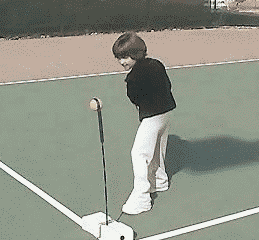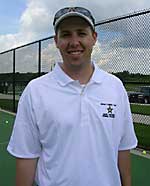|
TennisOne Lessons Teaching Tennis to Younger Kids Philosophy and Application, Part II David Brouwer Introduction In part I of this series on teaching Little Stars tennis, I introduced you to a number of my favorite warm up games for this age group. I also mentioned a few ideas about the philosophy of teaching children ages 4–6 the game of tennis. In this article, I'd like to share a few more of my favorite warm up games as well as give you some philosophy regarding equipment for children this age.
Equipment Equipment is an area where I believe many teaching professionals fail miserably as they try to introduce kids to the game of tennis. Keep in mind as you read this that success and fun are the name of the game when it comes to introducing kids to a game that they want to stick with long term. If they don't have success and they don't have fun, they won't be coming back to class! First, I believe that depressurized balls are a must. I have found success with three different types of balls: Regular depressurized balls (Wilson winners are what I use because they have multiple colors but pro penn stars and on-court off-court champs are the same type of ball), 90mm speed balls – this is a foam ball made by many companies (Wilson makes an EZ play ball, Dunlop makes a speed ball, and on-court off court makes a ball, among others), 90mm tail balls which are balls that have plastic streamers coming out of them so as to slow down the flight of the ball even more as it travels towards the child. The problem with real balls is that they are heavy, hard, and they bounce too high for 4–6 year olds to handle. Even if they can strike them off the feed, they have quite a tough time rallying a real ball, even with the coach.
Secondly, I believe that little nets are a must. As I mentioned in my last article, I have a six year old daughter who plays in one of my little stars classes. With the little nets (most of the time about 2–2.5 feet in height), she can look over the net at me. With a real net, she looks through the net at me. I believe that it's important to "graduate" the little stars to the bigger net when they can come close to looking over it so as to make the game as realistic as possible and give them the most success hitting over the net. Third, I believe that racquets are critical at this age. Between the ages of 4 and 6, there are many physical changes that happen to a child's height, weight, and strength. All of these need to be considered when watching a little star hit the ball. I like for them to really be able to whip the racquet around because I'm trying to teach them swing speed from a very young age. Therefore, I want the racquet to be short enough and light enough for them to really swing the racquet fast. If the racquet is too long or too heavy, they can't get it around to the ball. Lastly, I believe that teaching aides are a must. We put it right in the description of our classes that the kids can expect a "carnival like atmosphere." The way we create this is with colored cones, tubes, ladders, balls, hoops, and poly-spots. As much as they look great, they're also extremely useful for many games and for teaching the children how to follow directions. Telling everyone that you need them to "meet you by the red spot" makes a lot more sense than telling them that you need them to "meet you over there." It's specific and it's visual.
More Warm–up Games Popcorn This is a great game to work on hand–eye coordination, listening skills, leadership, and catching. The coach stands with his back to the students, who all have a cone or empty ball can in their hands. The coach has a hand full of balls and when he says "one, two, three" the kids all scream "popcorn!" At this point, the coach throws all the balls straight up in the air and the kids must catch as many of them as they can before they stop "popping." For the next couple times, let one of the students come forward and help the coach toss the balls up for the others to catch. Burglar This is a great game to get the kids moving and work on short bursts of movement needed for tennis. Set 10-15 balls on the center "T" and spread the kids in a large, even circle about 15 feet away from the balls with their racquets on the ground. When the coach says "go" every kid runs to the middle to grab a ball and bring it back to their racquet. Once the balls in the middle are gone, they can "burglarize" the other kids' tennis balls off of their racquets. The goal is for one kid to get a certain number of balls on their racquet, usually 4.
Keys to remember for this game are: Safety – spread the kids out enough so that they can see each other as they run from racquet to racquet and don't run into each other. Variation: Based on the age, ability, and stamina of the class, use either less balls in the middle, or raise or lower the number of balls to get on their racquet to be declared the winner. Spider in the web This is another great game for footwork, quick change of directions, and lots of fun. One kid starts as the spider. The rest are in the doubles alley. When the spider yells "spider in the web!" all the runners have to make it to the other doubles alley without being tapped. If they are tapped, they sit down and spread their "spider legs" out (arms) and try to get the other kids. Last one standing wins and becomes the spider in the next round. Some keys to remember here are: Safety – make sure the spider taps the others lightly so they don't push them and fall over. Boundaries – make sure the kids know that they have to stay inside the court lines and to be very aware of the net, which may get their feet tangled up.
Follow that ball This is a great warm up game to teach change of direction, shuffling, visual cues, and focus. The kids all line up on the baseline, arms length apart so there's some space between them. The coach stands on the service "T" with two tennis balls held together in front of his eyes. When the balls are together in front of his eyes, the students "bounce" in place. In other words, the movement that you see the pros use in between strokes where they dance with their feet. When the coach points the ball in his left hand to the left, the kids shuffle that way. Likewise to the right. When the balls come together, they bounce. The more adept the kids get at watching the balls and moving the correct way, the more the coach can try to trick them and make a fun game out of it. One variation is that no one ever gets "caught" and the other variation is that if a kid doesn't move the correct way, they come out and stand by the coach. Last one standing wins. Those are some more of my favorite warm up games for my Little Stars classes. Remember, I use these no more than 5 minutes at the beginning of each class to get the kids excited, get them moving, and lead them to discover certain movements, racquet skills, and hand-eye skills without them even knowing it. In my next article, I'll introduce you to the first couple of stroke concepts that I use with little stars and why I believe that teaching strokes to little stars is an issue more of allowing them to discover technique as opposed to learn technique. In the meantime, if you have any good warm up games that I can steal, please send them to me at dbrouwer@charter.net . Keep growing the game with little stars! Your comments are welcome. Let us know what you think about David Brouwer's article by emailing us here at TennisOne.
David was voted the USPTA Michigan Professional of the year in 2002 and has won two USPTA Outstanding Education awards. David has been a speaker at the USPTA Midwest and National conventions and is the Director of the West Michigan Tennis Academy. David coaches USTA league players of all levels and finds great joy in coaching strategy and tactics to build smarter tennis players. |

 David Brouwer, USPTA is the Director of Tennis for three major health clubs in Grand Rapids, MI.
David Brouwer, USPTA is the Director of Tennis for three major health clubs in Grand Rapids, MI.